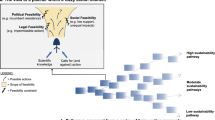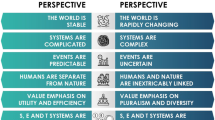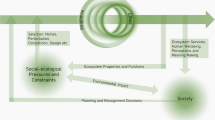Abstract
Owing to the rapidly evolving complexity within urban social and environmental systems, planners are increasingly facing the unenviable task of making important decisions about our socio-environmental futures with incomplete information. Rather than sacrifice environmentally responsive projects to future unpredictability arising from myriad, interactive urban complexities, we build on a range of literature on uncertainty in decision-making to develop the RAFT (reversibility, adaptability, flexibility and tailoring) framework. By humbly admitting the inevitability of unforeseen change and knowledge gaps, RAFT advances projects and decisional processes that are reversible, adaptable, flexible and tailored to changing conditions and policy contexts. It therefore supports the development of successful, forward-looking interventions, notwithstanding unpredictable futures.
This is a preview of subscription content, access via your institution
Access options
Subscribe to this journal
Receive 12 digital issues and online access to articles
$119.00 per year
only $9.92 per issue
Buy this article
- Purchase on SpringerLink
- Instant access to full article PDF
Prices may be subject to local taxes which are calculated during checkout



Similar content being viewed by others
References
Clos, J. From COP21 to the new urban agenda. UN Chronicle 52, 4–5 (2013).
Furtado, B. A., Sakowski, P. A. M. E. & Tóvolli, M. H. E. Modeling Complex Systems for Public Policies (IPEA, 2015).
Knopman, D. S. & Lempert, R. J. Urban Responses to Climate Change: Framework for Decisionmaking and Supporting Indicators (RAND, 2016).
IPCC. in Climate Change 2022: Impacts, Adaptation and Vulnerability. Working Group II Contribution to the Sixth Assessment Report of the Intergovernmental Panel on Climate Change Ch. 6, 907–1040 (Cambridge Univ. Press 2022).
Sengupta, U., Rauws, W. S. & de Roo, G. Planning and complexity: engaging with temporal dynamics, uncertainty and complex adaptive systems. Environ. Plan. B Plan. Des. 43, 970–974 (2016).
Rittel, H. W. J. & Webber, M. M. Dilemmas in a general theory of planning. Policy Sci. 4.2, 155–169 (1973).
Lempert, R. J., Popper, S. W. & Bankes, S. C. Shaping the Next One Hundred Years: New Methods for Quantitative Long-Term Policy Analysis (RAND, 2003).
Jaoude, G. A., Mumm, O. & Carlow, V. M. An overview of scenario approaches: a guide for urban design and planning. J. Plan. Lit. 37, 467–487 (2022).
Moroni, S. & Chiffi, D. Uncertainty and planning: cities, technologies and public decision-making. Perspect. Sci. 30, 237–259 (2022).
Boonstra, B. & Boelens, L. Self-organization in urban development: towards a new perspective on spatial planning. Urban Res. Pract. 4, 99–122 (2011).
Rauws, W. S. Why Planning Needs Complexity: Towards an Adaptive Approach for Guiding Urban and Peri-Urban Transformations (InPlanning, 2015).
Rauws, W. & De Roo, G. Adaptive planning: generating conditions for urban adaptability. Lessons from Dutch organic development strategies. Environ. Plan. B Plan. Des. 43, 1052–1074 (2016).
Renn, O., Klinke, A. & Schweizer, P.-J. Risk governance: application to urban challenges. Int. J. Disaster Risk Sci. 9, 434–444 (2018).
Pot, W., Scherpenisse, J. & Hart, P. Robust governance for the long term and the heat of the moment: temporal strategies for coping with dual crises. Public Admin. 101, 221–235 (2023).
Levins, R. & Lewontin, R. Dialectics and reductionism in ecology. Synthese 43, 47–78 (1980).
Renn, O., McCright, A. & Rosa, E. The Risk Society Revisited: Social Theory and Risk Governance (Temple Univ. Press, 2013).
Riva, F. et al. Toward a cohesive understanding of ecological complexity. Sci. Adv. 9, eabq420 (2023).
Vandermeer, J. & Perfecto, I. Ecological Complexity and Agroecology (Routledge, 2017).
Frank, D. M. Ethics of the scientist qua policy advisor: inductive risk, uncertainty and catastrophe in climate economics. Synthese 196, 3123–3138 (2019).
Weitzman, M. L. On modeling and interpreting the economics of catastrophic climate change. Rev. Econ. Stat. 91, 1–19 (2009).
Krueger, E. H. et al. Governing sustainable transformations of urban social-ecological-technological systems. Urban Sustain. 2, 10 (2022).
McPhearson, T. et al. A social-ecological-technological systems framework for urban ecosystem services. One Earth 5, 505–518 (2022).
Spier, F. Complexity in big history. Cliodynamics https://doi.org/10.21237/C7clio21213 (2011).
Holling, C. S. & Meffe, G. K. Command and control and the pathology of natural resource management. Conserv. Biol. 10, 328–337 (1996).
Taylor, P. J. Unruly Complexity: Ecology, Interpretation, Engagement (Univ. Chicago Press, 2010).
York, R. & Clark, B. The problem with prediction: contingency, emergence and the reification of projections. Sociol. Q. 48, 713–743 (2007).
Khmara, Y. & Kronenberg, J. On the road to urban degrowth economics? Learning from the experience of C40 cities, doughnut cities, transition towns and shrinking cities. Cities 136, 104259 (2023).
Manucci, S., Kwakkel, J. H., Morganti, M. & Ferrero, M. Exploring potential futures: evaluating the influence of deep uncertainties in urban planning through scenario planning: a case study in Rome, Italy. Futures 154, 103265 (2023).
Stern, P. C. On modeling worldviews in quantitative decision support. Risk Anal. 41, 870–873 (2021).
Lempert, R. J. & Turner, S. Engaging multiple worldviews with quantitative decision support: a robust decision‐making demonstration using the lake model. Risk Anal. 41, 845–865 (2021).
Levins, R. Strategies of abstraction. Biol. Philos. 21, 741–755 (2006).
Sarewitz, D., Pielke, R. A. & Byerly, R. (eds) Prediction: Science, Decision Making and the Future of Nature (Island Press, 2000).
Mitchell, S. Unsimple Truths: Science, Complexity and Policy (Univ. Chicago Press, 2009).
Van Wagtendonk, J. W. (ed.) Fire in California’s Ecosystems (Univ. California Press, 2018).
Bettencourt, L. M. A. Urban growth and the emergent statistics of cities. Sci. Adv. 6, eaat8812 (2020).
Parks, S. A. & Abatzoglou, J. T. Warmer and drier fire seasons contribute to increases in area burned at high severity in western US forests from 1985 to 2017. Geophys. Res. Lett. 47, e2020GL089858 (2020).
Sullivan, A. et al. Spreading like Wildfire—the Rising Threat of Extraordinary Landscape Fires (UNEP, 2022).
Carle, D. Introduction to Fire in California 2nd edn (Univ. California Press, 2021).
Youn, H. et al. Scaling and universality in urban economic diversification. J. R. Soc. Interface 13, 20150937 (2016).
Alfasi, N. & Portugali, J. Planning rules for a self-planned city. Plan. Theory 6, 164–182 (2007).
Moroni, S. Rethinking the theory and practice of land-use regulation: towards nomocracy. Plan. Theory 9, 137–155 (2010).
Partanen, J. Guiding urban self-organization: combining rule-based and case-based planning. Environ. Plan. B Urban Anal. City Sci. 47, 304–320 (2020).
United Nations Office for Disaster Risk Reduction. Strategic Approach to Capacity Development for Implementation of the Sendai Framework for Disaster Risk Reduction (UNDRR, 2018).
Anguelovski, I. et al. Equity impacts of urban land use planning for climate adaptation: critical perspectives from the global North and South. J. Plan. Educ. Res. 36, 333–348 (2016).
Howell, J. & Elliott, J. R. Damages done: the longitudinal impacts of natural hazards on wealth inequality in the United States. Soc. Problems 66, 448–467 (2019).
Elliott, J. R. & Clement, M. T. Natural hazards and local development: the successive nature of landscape transformation in the United States. Soc. Forces 96, 851–876 (2017).
Funtowicz, S. O. & Ravetz, J. R. Uncertainty, complexity and post‐normal science. Environ. Toxicol. Chem. Int. J. 13, 1881–1885 (1994).
Jiggins, J. & Röling, N. Adaptive management: potential and limitations for ecological governance of forests in a context of normative pluriformity. Adaptive Manag. Theory Pract. 3, 93–107 (2002).
Cajiao, D., Benayas, J., Tejedo, P. & Leung, Y. F. Adaptive management of sustainable tourism in Antarctica: a rhetoric or working progress? Sustainability 13, 7649 (2021).
Williams, B. K. et al. Adaptive Management: The US Department of the Interior Technical Guide. Adaptive Management Working Group (US Department of the Interior, 2009).
Renn, O., Klinke, A. & Van Asselt, M. Coping with complexity, uncertainty and ambiguity in risk governance: a synthesis. Ambio 40, 231–246 (2011).
Renn, O. & Klinke, A. A framework of adaptive risk governance for urban planning. Sustainability 5, 2036–2059 (2013).
Tierney, K. Resilience and the neoliberal project: discourses, critiques, practices—and Katrina. Am. Behav. Sci. 59, 1327–1342 (2015).
Sheshadri, A. et al. Midlatitude error growth in atmospheric GCMs: the role of eddy growth rate. Geophys. Res. Lett. 48, e2021GL096126 (2021).
Lawrence, J., Blackett, P. & Cradock-Henry, N. A. Cascading climate change impacts and implications. Clim. Risk Manag. 29, 100234 (2020).
Lempert, R., Popper, S. & Bankes, S. Confronting surprise. Soc. Sci. Comput. Rev. 20, 420–440 (2002).
Lempert, R. J. A new decision sciences for complex systems. Proc. Natl Acad. Sci. USA 99, 7309–7313 (2002).
Ahern, J. From fail-safe to safe-to-fail: sustainability and resilience in the new urban world. Landsc. Urban Plan. 100, 341–343 (2011).
Machiels, T., Goodspeed, R., Compernolle, T. & Coppens, T. Creating flexible plans for an uncertain future: from exploratory scenarios to adaptive plans with real options. Plan. Theory Pract. 24, 366–385 (2023).
Walker, W. E., Haasnoot, M. & Kwakkel, J. H. Adapt or perish: a review of planning approaches for adaptation under deep uncertainty. Sustainability 5, 955–979 (2013).
Lami, I. M. & Moroni, S. How can I help you? Questioning the role of evaluation techniques in democratic decision-making processes. Sustainability 12, 8568 (2020).
Weaver, C. P. et al. From global change science to action with social sciences. Nat. Clim. Change 4, 656–659 (2014).
Stern, P. in Structural Human Ecology (eds Dietz, T. & Jorgenson, A.) Ch. 6 (Washington State Univ. Press, 2013).
Tierney, K. From the margins to the mainstream? Disaster research at the crossroads. Annu. Rev. Sociol. 33, 503–525 (2007).
Schinko, T. et al. A framework for considering justice aspects in integrated wildfire risk management. Nat. Clim. Change 13, 788–795 (2023).
Campanella, T. J. Urban resilience and the recovery of New Orleans. J. Am. Plan. Assoc. 72, 141–146 (2006).
Shtob, D. A. Readiness at what cost? Trauma, displacement and opportunism in the Florida Keys. Front. Sustain. Cities 4, 936809 (2022).
Lynch, D. J. As cost of climate disasters grows, some profit with catastrophe bonds. Washington Post https://www.washingtonpost.com/business/2023/08/29/natural-disaster-investors-catastrophe-bonds/ (29 August 2023).
Schmidt, J. Incendiary assets: risk, power and the law in an era of catastrophic fire. Environ. Plan. A Econ. Space 56, 418–435 (2023).
Skeel, D. A. Debt's Dominion: A History of Bankruptcy Law in America (Princeton Univ. Press, 2002).
Marlow, T., Elliott, J. R. & Frickel, S. Future flooding increases unequal exposure risks to relic industrial pollution. Environ. Res. Lett. 17, 074021 (2022).
Loughran, K. & Elliott, J. R. The Policy Challenges of Urban Flooding, Managed Retreat and Social Equity (Temple University Public Policy Lab, 2021).
Siders, A. R. Social justice implications of US managed retreat buyout programs. Clim. Change 152, 239–257 (2019).
Swyngedouw, E. in Architectural Theories of the Environment (ed. Harrison, A. L.) 173–191 (Routledge, 2013).
De Vries, D. H. & Fraser, J. C. Citizenship rights and voluntary decision making in post-disaster US floodplain buyout mitigation programs. Int. J. Mass Emerg. Disasters 30, 1–33 (2012).
Wang, C., Medaglia, R. & Zheng, L. Towards a typology of adaptive governance in the digital government context: the role of decision-making and accountability. Gov. Inf. Q. 35, 306–322 (2018).
Moroni, S. & Tricarico, L. Distributed energy production in a polycentric scenario: policy reforms and community management. J. Environ. Plan. Manag. 61, 1973–1993 (2018).
Ostrom, E. Polycentric systems for coping with collective action and global environmental change. Global Environ. Change 20, 550–557 (2010).
Savini, F., Majoor, S. & Salet, W. Dilemmas of planning: intervention, regulation and investment. Plan. Theory 14, 296–315 (2015).
Carlisle, K. & Gruby, R. L. Polycentric systems of governance: a theoretical model for the commons. Policy Stud. J. 47, 927–952 (2019).
Thiollent, M. Action research and participatory research: an overview. Int. J. Action Res. 7, 160–174 (2011).
Erikson, K. & Peek, L. The Continuing Storm: Learning from Katrina (Univ. Texas Press, 2022).
Kasperson, R. in Structural Human Ecology: New Essays in Risk, Energy and Sustainability (eds Dietz, T. & Jorgenson, A.) Ch. 5 (Washington State Univ. Press, 2013).
Chignell, S. M. & Laituri, M. J. in Geoscience for the Public Good and Global Development: Toward a Sustainable Future (eds Wessel, G. R. & Greenberg, J. K.) 125–136 (Geological Society of America, 2016).
Strauss, B. Coastal mations, megacities face 20 feet of sea rise. Climate Central https://www.climatecentral.org/news/nations-megacities-face-20-feet-of-sea-level-rise-19217 (Climate Central, 2015).
Acknowledgements
We thank G. Smithsimon, D. Hess, J. Gilligan and the University of Washington CSDE for their help and encouragement.
Author information
Authors and Affiliations
Contributions
All authors contributed equally to this work. D.A.S. conceived the original idea, D.A.S., J.F. and P.T.G. developed the idea, concepts and intervention, reviewed the literature and wrote the paper. P.T.G. designed the graphics with assistance from D.A.S.
Corresponding author
Ethics declarations
Competing interests
The authors declare no competing interests.
Peer review
Peer review information
Nature Cities thanks Weiqi Zhou and the other, anonymous, reviewer(s) for their contribution to the peer review of this work.
Additional information
Publisher’s note Springer Nature remains neutral with regard to jurisdictional claims in published maps and institutional affiliations.
Rights and permissions
Springer Nature or its licensor (e.g. a society or other partner) holds exclusive rights to this article under a publishing agreement with the author(s) or other rightsholder(s); author self-archiving of the accepted manuscript version of this article is solely governed by the terms of such publishing agreement and applicable law.
About this article
Cite this article
Shtob, D.A., Fox, J. & Greiner, P.T. Planning for the complexity and uncertainty of urban socio-environmental futures. Nat Cities 2, 187–197 (2025). https://doi.org/10.1038/s44284-024-00195-6
Received:
Accepted:
Published:
Issue date:
DOI: https://doi.org/10.1038/s44284-024-00195-6
This article is cited by
-
Disparities of urban morphology effects on compound natural risks: a multiscale study across the USA
npj Urban Sustainability (2025)



